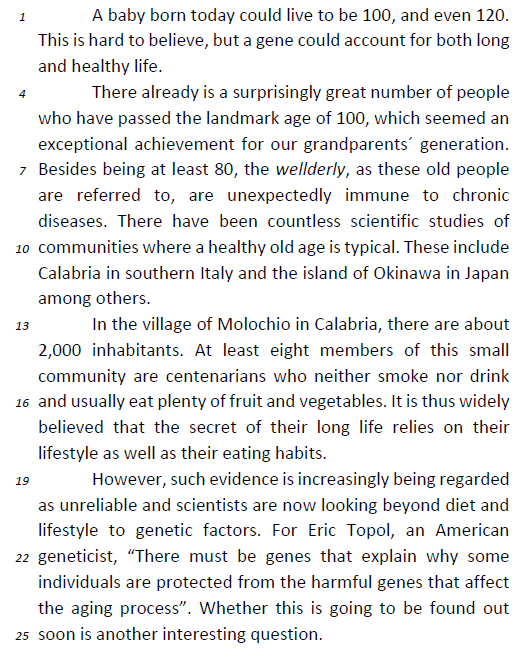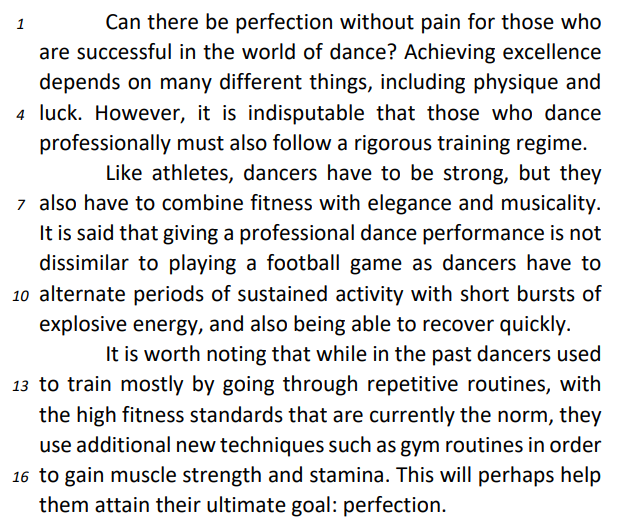Questões de Concurso
Sobre advérbios e conjunções | adverbs and conjunctions em inglês
Foram encontradas 577 questões
In the sentence “The taxi, an old Rover smelling of old cigarette smoke, trundled along the empty, country road at an unhurried pace”, the words “empty” and “country” are used as
To exercise or not to exercise ...
Are more young people overweight than in the past and do they exercise enough? We decided to ask four young people what they thought about this problem.
1- HEATHEROHURUOGU, aged 14 from Leeds, tells us what she thinks about keeping fit. “I know there have been a lot of stories in newspapers about how fat young people are getting, but we're not all sitting at home at a computer eating crisps and chocolate. Some of us do actually realise that keeping fit is quite important. If anybody should be blamed, I think schools and parents are the problem. At my school we have fewer hours of PE lessons than we used to have. The school has decided we need to spend more time preparing for our exams. My mum and dad trust me to take a bus home if I stay late at school for hockey training, but my friend Carly can't come because her parents work and they are worried about her travelling alone.”
2- OLIVER MCKENNA, aged 15, Edinburgh, sees things differently.
“I don't like organised sport or spending my time with guys skateboarding. I love computers – programming them, playing games on them, surfing the Internet and in my free time that's what I do. It's true that I do need to lose some weight, though. Next week, Mum's taking me to a doctor so we can ask about going on a diet. Dad wants me to join the gym he goes to, but I think it's a bit boring working out all the time. In fact, there's a computer game now called Wii. I'm thinking of getting it because you actually do the actions of the games – you know, things like swinging your arm to hit the ball in tennis. That'd be a good way to get some exercise!”
3- REECEWILKINS, aged 13, Swansea, has another view.
“I'm an active person and so are most of my friends. We all like to spend some time on our Nintendos, PlayStations or whatever – all young people enjoy computer games – but we also belong to football teams or some kind of sports club. We don't have to make an effort to be fit – young people like active games. No, our problem is that we eat too much rubbish. In fact, we drink a lot of bad things – sweet, fizzy drinks which are full of sugar and very unhealthy. Also, we all love fast food and often eat hamburgers and chips. If we ate better, I think most of us would lose the extra weight we have.”
4- HANK DARROW, aged 14, London, shares his opinions with us.
“I've spent the last four years trying to lose weight, and it hasn't been easy. My problem started when I was a baby – it wasn't really my fault. You see, I wasn't very interested in food, and so my mum made all kinds of delicious things to get me to eat. Of course, all those tasty foods were very fattening. My mum used to carry a bowl of food everywhere we went and would follow me around the house or playground trying to get me to eat just one more bite. Well, I got used to eating constantly and, by the time we all realised that I had gained too much weight, the damage had been done. Now I follow a special diet – it was hard at first, but once I got used to it, I actually like it.And I look and feel so much better – I don't want to go back to the way I was.”
Taken from: CHAPMAN, Joanne. Laser B1 +. Teacher's book. Macmillan, 2008.
In the sentence: “Some of us do actually realise that keeping fit is quite important” (Heather's opinion), ACTUALLY means:
Team Composition
In a large organization, it is often the case that different roles emerge. In Tayloristic teams, these different roles are grouped together as a number of role-based teams each of which contains members of the same role. In contrast, agile teams use cross-functional teams. Such a team draws together individuals performing all defined roles. Rotations from one role to another are common. It is also possible to have highly specialized experts (for example, security analysts and usability engineers) shared among several teams in an organization.
One advantage to role-based teams is that teams whose work products are independent of each other can work in parallel as long as there is not much knowledge flow among the different functional sub-team. However, in knowledgeintensive software development that demands information flow from different functional sub teams, role-based teams tend to lead to islands of knowledge and difficulty in its sharing among all the teams. As hand-offs between teams usually are based on document flow, the knowledge of one team that is required by the other team must be externalized and documented. Although reviews try to minimize the knowledge loss, externalization and documentation processes cannot guarantee that all knowledge is captured and even if most of it was rigorously captured, there is still no guarantee or way to check its correctness till the project sign-off.
Cross-functional teams should be used to facilitate better knowledge transfer. This is especially the case for agile methods since they are recommended to be used where there is a lot of uncertainty and unknown knowledge about the domain and system requirements, and the technologies to be used are new and unexplored.
Adaptado de: CHAU THOMAS, MAURER FRANK e MELNIK GRIGORI. Knowledge Sharing: Agile Methods vs. Tayloristic Methods. (WETICE´03) Proceedings of the Twelft IEEE International Workshop on Enabling Technologies: Infrastructure for Collaborative Enterprises, 2003.
Text for the item.
A long and healthy life?

Internet: <www.ngllife.com> (adapted).
Based on the text, judge the following item.
If is not a correct alternative for “Whether” in “Whether
this is going” (line 24).
Text for the item.
A long and healthy life?

Internet: <www.ngllife.com> (adapted).
Based on the text, judge the following item.
“Besides”, in “Besides being at least 80” (line 7), and in
addition to are synonyms.
Text for the item.
A long and healthy life?

Internet: <www.ngllife.com> (adapted).
Based on the text, judge the following item.
The term “wellderly” (line 7) refers to anyone who
turns 80.
Text for the question.
The route to perfection

TEXTO I
English for Specific Purposes
English for specific purposes (ESP) refers to language research and instruction that focuses on the specific communicative needs and practices of particular social groups. Emerging out of Halliday, Macintosh, and Strevens’ (1964) groundbreaking work nearly 40 years ago, ESP started life as a branch of English language teaching, promising a stronger descriptive foundation for pedagogic materials. In the years since, ESP has consistently been at the cutting-edge of both theory development and innovative practice in applied linguistics, making a significant contribution to our understanding of the varied ways language is used in particular communities. Drawing on a range of interdisciplinary influences for its research methods, theory, and practices, ESP has consistently provided grounded insights into the structures and meanings of texts, the demands placed by academic or workplace contexts on communicative behaviors, and the pedagogic practices by which these behaviors can be developed.
HYLAND, K. “English for specific purposes: some influences and impacts”. In: Cummins, J. and Davison, C., (eds.) The International Handbook of English language education. Springer: Norwell, Mass, 2006.
Based on the text, judge the following item.
The word “likely” (line 13) expresses probability.
Based on the text, judge the following item.
The adverb Actually cannot be used instead of “As a matter of fact” (line 7).
Based on the text, judge the following items.
Based on the text, judge the following item.
At the present time expresses the same idea as “Actually” (line 11).
Based on the text, judge the following item.



